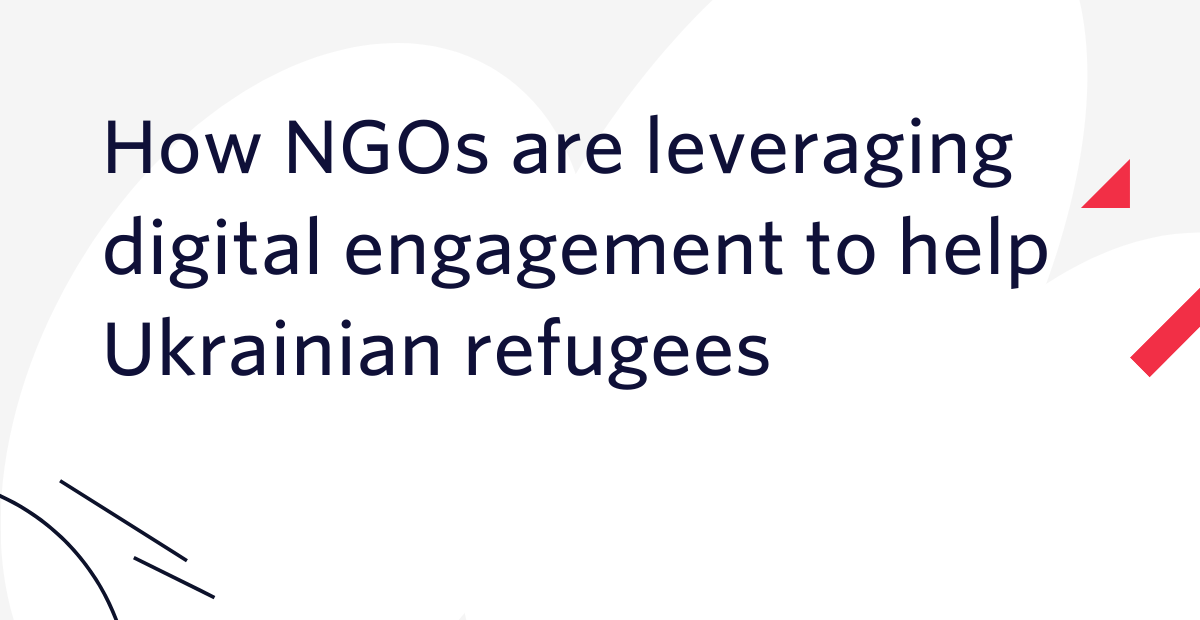How NGOs are leveraging digital engagement to help Ukrainian refugees
Time to read: 5 minutes

When people are at risk due to conflict, crises, and war, social impact builders rise up to help. Today’s war in Ukraine is no different. We’re devastated by the loss of life and the attack on democracy and freedom, but we’re finding hope in the way communities are rallying to support displaced people. Nonprofits, NGOs, volunteer groups, and businesses are building innovative solutions to support people leaving their homes to reach safety.
Here are the top use cases we’re seeing for how impact organizations are leveraging digital communications and Twilio products to support the people displaced by the war in Ukraine. Check out the linked resources to get started building your own communications app, or reach out to our team for additional support. We’re happy to help walk through technical approaches and offer nonprofit product discounts.
Notifications to combat misinformation
Trusted news organizations are working to help people in Ukraine understand the movement of the Russian army and combat misinformation. These media organizations are building ways for people in the region to opt-in to regular updates and notifications from trusted sources about what is happening to help guide their plans. Other organizations are building notification apps to help Ukrainians find out when airstrikes are happening and share news on the ground.
Get started building notifications:
- Send WhatsApp Notification Messages with Templates
- Broadcast a Voice Message to Multiple Numbers Using PHP
Telemedicine to care from afar
With so many people leaving Ukraine, many people are struggling to access medical care and address routine health issues. Many organizations are ramping up their online medical support to care for people impacted by the crisis using video and voice communications. For instance, DocPlanner and Zapytaj Lekarza are helping match patients with doctors and offering medical consultations.
Get started building telemedicine:
- Building a Next-Generation Virtual Care Platform: A Step-By-Step Guide
- Code Exchange: Virtual Medical Visits
- Code Exchange: Appointment Reminders via SMS
Chatbots to direct displaced people to resources
Organizations like the Norwegian Refugee Council are building chatbots that help direct people fleeing their homes due to conflict to helpful resources. They will soon bring the program, which is available in other countries experiencing conflict, to Ukraine. When a person messages in over WhatsApp for support, the NGO first conducts a needs assessment over chat. For example, they will ask what situation the person is in, and what type of support is needed, such as a place to stay, food assistance, or medical care. Based on the needs, the NGO then will recommend local resources that can support. To identify eligibility for resources, the organization is building a feature to allow people to upload documents securely over WhatsApp.
Get started building chatbots:
- Build a chatbot with Twilio Studio
- Code Exchange: Build an FAQ Chatbot with Twilio Flex
- Build an SMS Chatbot with Python
Cash transfers for direct aid
Humanitarian organizations have learned that people who’ve been displaced from their homes often prefer direct cash vouchers to other forms of aid. Perhaps they need food, shelter, or clothes for their family – with cash support, they can prioritize their own needs. Organizations working on refugee cash support are building account set up and eligibility notifications with WhatsApp and SMS. Others are setting up chat experiences for folks to check voucher balances. For instance, RedRose builds payments, communications, and account verification infrastructure for nonprofits to deliver these cash vouchers securely.
Get started building account notifications:
- Build a Voice Call Donation System Using Twilio Studio and Pay
- Payment Processing with Twilio Tutorial
- SMS Alerts Best Practice Guide
Providing equitable access to information and support
People and organizations all around the world have been finding ways to support the people impacted by the war in Ukraine. However, language barriers have made it more difficult for people from other countries to support those impacted. To help nonprofits source translators and connect over video, Tarjimly built a volunteer network providing on-demand translation services. Migam is connecting Ukrainian refugees who are deaf or hard of hearing to critical government and financial services. The organization is providing instant access to a sign language interpreter via Twilio’s Video API. Others are building speech translation into their voice apps and integrating translation partners like Lionbridge.
Get started building translation:
- Volunteer for or use Tarjimly’s video translation services
- Launch your own video app with text-based chat in minutes
- Build a speech translation bot with Programmable Voice
Safety and crisis hotlines
To help protect people fleeing and others still in Ukraine, many organizations are building hotlines on Twilio Flex. Some are providing humanitarian assistance others are helping journalists keep safe. When a person calls or messages in, they may be asked a few common questions to help route the request. Then, either a helpful common response is shared or the request is transferred to a live support agent.
Get started building a hotline on Flex:
- Modernize Your Crisis Hotline with Twilio Flex
- Two-way Communication for Humanitarian Operations with USSD in Twilio Flex
- Twilio Flex documentation
Supply delivery logistics and coordination
Food, medical supplies, hygiene products, clothing – these are just a few of many items needed to support people in Ukraine and those who’ve traveled to neighboring countries. NGOs, businesses, and governments working through supply deliveries are using messaging to coordinate with drivers and their intended recipients and locations. For instance, Della UA is delivering humanitarian aid from Poland to Ukraine and coordinating volunteers around Europe.
Getting started building delivery notifications:
- Code Exchange: SMS Notifications
- Conversations API Sample Application and UI Kit
- Anonymous SMS Conversation
- Twilio Frontline Node.js Quickstart
Connectivity options in the region
Here are a few notes to keep in mind when building communications for people in and near Ukraine with Twilio.
- Evaluate relevant messaging channels: Twilio has pre-built channels with WhatsApp and Facebook Messenger. Apps like Viber and Telegram are even more popular in the region, and Signal is gaining traction. Learn how to connect Twilio to Viber and Telegram on our blog. These messaging channels are best for two-way text communications. If a local SMS number is required, Twilio can be integrated with an SMS gateway like Telerivet.
- Review your options for phone numbers: Work with your Twilio account representative to identify the best number options for your needs. While Twilio does not currently have phone numbers in Ukraine available, you can choose numbers from nearby countries where we have availability (ex: Poland, Slovakia, Hungary, and Moldova), bring your own number, or apply for a Toll-Free number. For messaging, you can use Alphanumeric Sender ID to deliver one-way outbound messages.
- Consider building in callbacks: To help reduce telecommunications costs for people who call into your service, especially when using international phone numbers, we recommend considering building a call back feature in Flex or with Task Router and Twilio Functions. With callbacks, your NGO or organization pays for the call instead of the client who initiated the connection.
In times of crisis, digital communications can help extend the helping hands of volunteers and staff on the ground. While these are the initial use cases we’re seeing to support Ukrainian relief efforts, we expect to see more innovation to align with the unique needs of the region and situation.
Twilio.org, Twilio’s social impact team, is committed to helping NGOs supercharge their impact efforts with digital communication tools and financial resources. If you’d like support on your impact project for Ukraine, please sign up for our nonprofit product discount program and get in touch with our team. We’d love to help.
Related Posts
Related Resources
Twilio Docs
From APIs to SDKs to sample apps
API reference documentation, SDKs, helper libraries, quickstarts, and tutorials for your language and platform.
Resource Center
The latest ebooks, industry reports, and webinars
Learn from customer engagement experts to improve your own communication.
Ahoy
Twilio's developer community hub
Best practices, code samples, and inspiration to build communications and digital engagement experiences.


